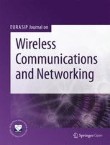EURASIP Journal on Wireless Communications and Networking welcomes submissions to the special issue on Recent Advances in Internet of Things Security and Privacy.
Internet of Things (IoT) enable both traditional electronics and everyday “things” embedded with sensors, computing, and networking capabilities to connect to the Internet as well as to send and receive data. Currently, IoT has been applied in many emerging applications, such as smart city and big data. It is no doubt that the power of typical IoT applications roots on their abilities to collect, understand, and interact with a user’s life in a pervasive and intimate fashion. Furthermore, the future IoT is doomed to be more complicated in terms of capability, adaptability, security, privacy, and usability. On the other hand, obviously, empowering intelligent IoT systems with massive private data can raise serious security and privacy issues. However, the industry has no effective ways to fully secure IoT, and the research for IoT systems is still at the very initial phase. Therefore, the investigation on IoT security and privacy is attracting more and more attentions from both industry and academia. The central theme of this special issue is to investigate novel methodologies and theories for IoT security and privacy. This special issue encourages submissions of high-quality unpublished papers reporting original works in both theoretical and experimental research in the area of recent advances in IoT.
Optimization methods are applied widely to several problems to wireless communications and information processing in general. These, among others, include convex optimization, heuristic methods, evolutionary algorithms (EAs), machine learning methods, and artificial neural networks (ANNs). The use of all of the above has an increasing impact to key enabling technologies. Additionally, hybrid combinations of Artificial Intelligence (AI) techniques and other optimization methods are also emerging.
Potential topics include but are not limited to:
- Secure and Trustworthy IoT Systems
- Cyberattack analysis and defense for IoT
- Vulnerability analysis and security enforcement for IoT infrastructures, systems, and protocols
- Vulnerability analysis and security enforcement for IoT communication and networking
- Mobile IoT Services Security
- Intrusion and detection techniques for IoT
- Online behavioral risks to security and/or privacy for IoT
- Risk management for IoT
- Disaster recovery for IoT
- Context-awareness and Location-awareness in IoT
- Data security and recovery for IoT
- Data breaches analysis in IoT
- Privacy preserving for IoT communication and networking
- Privacy preserving on data storage and management for IoT
- Privacy preserving on data processing and mining for IoT
- Privacy preserving on data collection and analytics for IoT
- Privacy preserving on data fusion for IoT
- Interaction design on accommodation of individual and/or collective privacy values and concerns for IoT
- Methods for modeling intentions and/or behaviors relevant to cybersecurity and privacy for IoT
Submission Instructions
Before submitting your manuscript, please ensure you have carefully read the submission guidelines for EURASIP Journal on Wireless Communications and Networking. The complete manuscript should be submitted through the EURASIP Journal on Wireless Communications and Networking submission system. To ensure that you submit to the correct speical issue please select the appropriate special issue in the drop-down menu upon submission. In addition, indicate within your cover letter that you wish your manuscript to be considered as part of the special issue on Recent Advances in Internet of Things Security and Privacy. All submissions will undergo rigorous peer review and accepted articles will be published within the journal as a collection.
Deadline for submissions: 1 September 2018
Lead Guest Editor
Wei Li, Department of Computer Science, Georgia State University, GA, USA
Guest Editors
Meng Han, Kennesaw State University, GA, USA
Sanish Rai, West Virginia University Institute of Technology, WV, USA
Chunqiang Hu, Chongqing University, China
Dongxiao Yu, Huazhong University of Science and Technology, China
Submissions will also benefit from the usual advantages of open access publication:
- Rapid publication: Online submission, electronic peer review and production make the process of publishing your article simple and efficient
- High visibility and international readership in your field: Open access publication ensures high visibility and maximum exposure for your work - anyone with online access can read your article
- No space constraints: Publishing online means unlimited space for figures, extensive data and video footage
- Authors retain copyright, licensing the article under a Creative Commons license: articles can be freely redistributed and reused as long as the article is correctly attributed
For editorial enquiries please contact kimberly.ramos@biomedcentral.com.
Sign up for article alerts to keep updated on articles published in EURASIP Journal on Wireless Communications and Networking - including articles published in this special issue!
